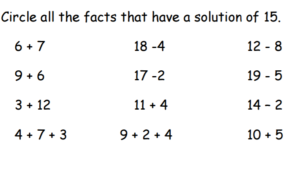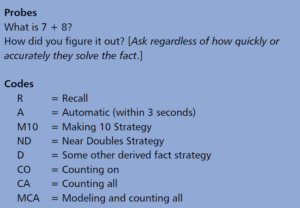MAFS.2.OA.2.2 Fluently add and subtract within 20 using mental strategies. By end of Grade 2, know from memory all sums of two one-digit numbers.
Cognitive Complexity Level: 1-Recall
[divider] [/divider] Students are able to…
- Use a variety of materials (manipulatives, ten frames, number lines, hundreds chart) to solve and justify sums and differences within 20.
- Apply and explain mental strategies for recalling basic facts within 20.
- Demonstrate fluency with sums to 20 (recalling within approximately 3 seconds).
[divider] [/divider] Students are able to…because teachers:
- Engage students in creating concrete and representational models to develop understanding of fact retrieval strategies.
- Facilitate conversation among students about basic fact retrieval strategies.
- Assess learners and provide differentiated opportunities for students to rehearse fact retrieval strategies (using games, activities, computer programs, and small group instruction).
[divider] [/divider] Questions to ask students:
- Ask: What are some ways to find the sum of 7 and 6?
- Sample answer that indicates understanding: “ I know double 6 is 12 and one more is 13” “I know 7 and 3 more make 10 and there are two 3’s in 6 so 13”
- Sample answer that indicates an incomplete understanding or a misconception: Student needs to use concrete tools or draw a picture to find sum. The student may not be ready for near doubles or make a ten mental strategies. Ask how they would solve 9 + 2 to see if they are able to apply the count on strategy.
- Ask: What fact strategy are you focusing on and how they are practicing it in the activity?
- Sample answer that indicates understanding: “I am working on make a ten so I break apart/decompose one addend/number to make ten with the other and then I add on the rest.”
- Ask: students When might use near doubles as a strategy to find a sum?
- Sample answer that indicates understanding: “9+ 8 is a near double fact because you can do double 8 plus 1 or double 9 minus 1 to find the sum.”
- Ask students: What strategy would you use to solve 13 – 8?
- Sample answer that indicates understanding: “I would count up from 8 so two more makes ten and three more makes 13, the difference is 5.” “I would break 13 into ten and three then subtract eight from ten resulting in 2 and then the 3 makes 5.”
[divider] [/divider] Additional Resources:
Additional in depth content knowledge
Blog Post: Assessing Mathematical Fluency
http://smathsmarts.com/assessing-mathematical-fluency/
Video: Adding and subtracting using doubles facts
https://learnzillion.com/lesson_plans/5038-adding-and-subtracting-using-doubles-facts
[divider] [/divider] Sample Formative Assessment Tasks:
[divider] [/divider] Resources/Tasks to Support Your Child at Home:
- Task: John had 7 red jelly beans and 5 blue jelly beans. How many jelly beans does John have? Explain how you can use ten to add.
- Digital games (levels 1 and 2 ) to practice addition fluency http://goo.gl/M88wa
- Task: Kelly had a bag of 12 jelly beans. 4 are green and the rest are yellow. How many jelly beans are yellow? Explain how you can use ten to subtract.
- Digital games (levels 1 and 2 ) to practice subtraction fluency http://goo.gl/CIXvF
- Students need to have their doubles mastered before they can use doubles to add and subtract. Look for real-word examples of doubles with your child.
- Examples:
-fingers on your hands 5 + 5
– legs on a ladybug 3 + 3
-rows of eggs in a carton 6 + 6
-days in 2 weeks 7 + 7
- Examples:
- Learn Zillion Video: Use Doubles to Add and Subtract Within 20 https://bit.ly/2KBsGj0
- Greg Tang Math: Math Limbo – game to practice facts http://gregtangmath.com/mathlimbo


